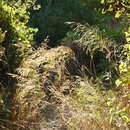Comprehensive Description
provided by North American Flora
Oryzopsis miliacea (L.) Benth. & Hook. ; Aschers. & Schweinf
Mem. Inst. Egypt. 2: 169. 1887.
Agroslis miliacea L. Sp. PI. 61. 1753.
Achnatherum miliaceum Beauv. Agrost. 20, 146, 148. 1812. (Based on Agroslis miliacea L.)
Piptatherum miliaceum Coss. Notes Crit. 129. 1851. (Based on Agroslis miliacea L.)
Culms erect from a decumbent base, relatively stout, sometimes branching, 60-150 cm. tall, glabrous or scaberulous, the nodes several; sheaths glabrous, mostly shorter than the internodes, somewhat keeled; ligule truncate, scaberulous, 1-2 mm. long; blades flat, glabrous or nearly so beneath, scaberulous on the upper surface, 20-30 cm. long, 4-8 mm. wide; panicle 15—30 cm. long, erect or somewhat nodding, loose, the branches ascending or spreading, 5-10 cm. long, verticillate, naked below, often with some short leaves intermixed, the axis glabrous, the branches scabrous; pedicels scabrous, the lateral about 1 mm. long; glumes 3 mm. long, glabrous, rather abruptly acuminate, faintly 3-nerved, minutely scaberulous; lemma glabrous, oblong-elliptic, 2 mm. long; awn straight or slightly flexuous, 4 mm. long.
Type locality: Europe.
Distribution: Open ground and waste places, southern California; ballast, near Philadelphia; introduced from the Mediterranean.
- bibliographic citation
- Albert Spear Hitchcock. 1935. (POALES); POACEAE (pars). North American flora. vol 17(6). New York Botanical Garden, New York, NY
Physical Description
provided by USDA PLANTS text
Perennials, Terrestrial, not aquatic, Stems nodes swollen or brittle, Stems erect or ascending, Stems geniculate, decumbent, or lax, sometimes rooting at nodes, Stems caespitose, tuf ted, or clustered, Stems terete, round in cross section, or polygonal, Stems branching above base or distally at nodes, Stem internodes hollow, Stems with inflorescence less than 1 m tall, Stems with inflorescence 1-2 m tall, Stems, culms, or scapes exceeding basal leaves, Leaves mostly cauline, Leaves conspicuously 2-ranked, distichous, Leaves sheathing at base, Leaf sheath mostly open, or loose, Leaf sheath smooth, glabrous, Leaf sheath and blade differentiated, Leaf blades linear, Leaf blades 2-10 mm wide, Leaf blades mostly flat, Leaf blades mostly glabrous, Leaf blades scabrous, roughened, or wrinkled, Ligule present, Ligule an unfringed eciliate membrane, Inflorescence terminal, Inflorescence an open panicle, openly paniculate, branches spreading, Inflorescence solitary, with 1 spike, fascicle, glomerule, head, or cluster per stem or culm, Inflorescence lax, widely spreading, branches drooping, pendulous, Inflorescence with 2-10 branches, Flowers bisexual, Spikelets p edicellate, Spikelets dorsally compressed or terete, Spikelet less than 3 mm wide, Spikelets with 1 fertile floret, Spikelets solitary at rachis nodes, Spikelets all alike and fertille, Spikelets bisexual, Spikelets disarticulating above the glumes, glumes persistent, Rachilla or pedicel glabrous, Glumes present, empty bracts, Glumes 2 clearly present, Glumes equal or subequal, Glumes shorter than adjacent lemma, Glumes 3 nerved, Lemma coriaceous, firmer or thicker in texture than the glumes, Lemma 3 nerved, Lemma glabrous, Lemma apex truncate, rounded, or obtuse, Lemma distinctly awned, more than 2-3 mm, Lemma with 1 awn, Lemma awn less than 1 cm long, Lemma awned from tip, Lemma awns straight or curved to base, Lemma margins thin, lying flat, Lemma straight, Palea present, well developed, Palea about equal to lemma, Palea 2 nerved or 2 keeled, Stamens 3, Styles 2-fid, deeply 2-branched, Stigmas 2, Fruit - caryopsis, Caryopsis ellipsoid, longitudinally grooved, hilum long-l inear.
Piptatherum miliaceum: Brief Summary
provided by wikipedia EN
Piptatherum miliaceum is a species of grass known by the common name smilograss. It is native to Eurasia but it can be found in many other parts of the world as an introduced species and a casual weed of disturbed areas. It is a clumping perennial grass producing sturdy, erect stems that can reach 1.5 meters tall. The inflorescence is a panicle of several whorls of branches that divide into secondary branches bearing clusters of spikelets.
- license
- cc-by-sa-3.0
- copyright
- Wikipedia authors and editors

